Business Finance Report: Analysis of T-shirt Ltd Financials
VerifiedAdded on 2023/01/04
|15
|3568
|45
Report
AI Summary
This report provides a detailed financial analysis of T-shirt Ltd, examining its performance through profit and loss statements, balance sheets, and various financial ratios. The report evaluates the company's gross profit, net profit, and operating profit ratios, highlighting trends from 2018 to 2019. It also assesses the company's financial position using current, receivable turnover, and payable turnover ratios. Furthermore, the report compares accrual versus cash accounting methods and discusses the differences between profit and cash flows. The report concludes with a brief discussion on the meaning and purposes of budgets, as well as the benefits of forming a limited company and listing it on a stock exchange.

Business Finance
Paraphrase This Document
Need a fresh take? Get an instant paraphrase of this document with our AI Paraphraser

Contents
INTRODUCTION.......................................................................................................................................3
MAIN BODY..............................................................................................................................................3
PART 1....................................................................................................................................................3
1 Statement of profit and loss..................................................................................................................3
2 Statement of financial position.............................................................................................................6
PART 2....................................................................................................................................................9
1. Accruals vs. cash accounting...............................................................................................................9
2. Profit vs. Cash flows..........................................................................................................................11
PART 3..................................................................................................................................................11
1. Meaning and Purposes of budget.......................................................................................................11
2. Benefits of forming a limited company and getting it registered on a stock exchange......................12
CONLCUSION.........................................................................................................................................13
REFERENCES..........................................................................................................................................14
INTRODUCTION.......................................................................................................................................3
MAIN BODY..............................................................................................................................................3
PART 1....................................................................................................................................................3
1 Statement of profit and loss..................................................................................................................3
2 Statement of financial position.............................................................................................................6
PART 2....................................................................................................................................................9
1. Accruals vs. cash accounting...............................................................................................................9
2. Profit vs. Cash flows..........................................................................................................................11
PART 3..................................................................................................................................................11
1. Meaning and Purposes of budget.......................................................................................................11
2. Benefits of forming a limited company and getting it registered on a stock exchange......................12
CONLCUSION.........................................................................................................................................13
REFERENCES..........................................................................................................................................14

INTRODUCTION
Business entities are expected to effectively conduct their business activities by controlling their
financial capital. Finance is the cash influx from which the net operations of the organization
have grown. It's the nature of a business (Connolly and Bank, 2020). T-shirt Ltd has taken into
consideration the extent of brand funding. This report offers an overview of the practices of the
organization by analyzing the financial ratio and evaluating it. This also describes the use of cash
and reliable. Apart from this, each ratios are measured in terms of various kinds of aspects
including balance sheet, income statement etc.
MAIN BODY
PART 1
1 Statement of profit and loss.
A statement of sales or a P&L report is a detailed report of the firm’s information which is
essentially a report for a given time frame of income and costs. It shows the manner in which
earnings are turned into corporation revenues and expenses (Lewis and Liu, 2020). In the context
of T-shirt limited, it is assessed that in 2019 the firm faced a loss of 500 million and on the
contrary, in the past period of 2018 it also had a net profit of 372 million. The following figures
are helpful for the estimation of net profits in order to create a reliable and fair view of the
company's financial position:
Gross profit ratio: It is essentially a measure of the excess of revenue over gross receipt by the
company. It takes into account the specific expenses and not the indirect ones. By deducting
COGS from total business receipts, total revenue is received. Gross margin, sometimes referred
to as the gross revenue ratio and sales are also measured.
2018 2019
Gross profit ratio 60.02% 45.02%
Business entities are expected to effectively conduct their business activities by controlling their
financial capital. Finance is the cash influx from which the net operations of the organization
have grown. It's the nature of a business (Connolly and Bank, 2020). T-shirt Ltd has taken into
consideration the extent of brand funding. This report offers an overview of the practices of the
organization by analyzing the financial ratio and evaluating it. This also describes the use of cash
and reliable. Apart from this, each ratios are measured in terms of various kinds of aspects
including balance sheet, income statement etc.
MAIN BODY
PART 1
1 Statement of profit and loss.
A statement of sales or a P&L report is a detailed report of the firm’s information which is
essentially a report for a given time frame of income and costs. It shows the manner in which
earnings are turned into corporation revenues and expenses (Lewis and Liu, 2020). In the context
of T-shirt limited, it is assessed that in 2019 the firm faced a loss of 500 million and on the
contrary, in the past period of 2018 it also had a net profit of 372 million. The following figures
are helpful for the estimation of net profits in order to create a reliable and fair view of the
company's financial position:
Gross profit ratio: It is essentially a measure of the excess of revenue over gross receipt by the
company. It takes into account the specific expenses and not the indirect ones. By deducting
COGS from total business receipts, total revenue is received. Gross margin, sometimes referred
to as the gross revenue ratio and sales are also measured.
2018 2019
Gross profit ratio 60.02% 45.02%
⊘ This is a preview!⊘
Do you want full access?
Subscribe today to unlock all pages.

Trusted by 1+ million students worldwide
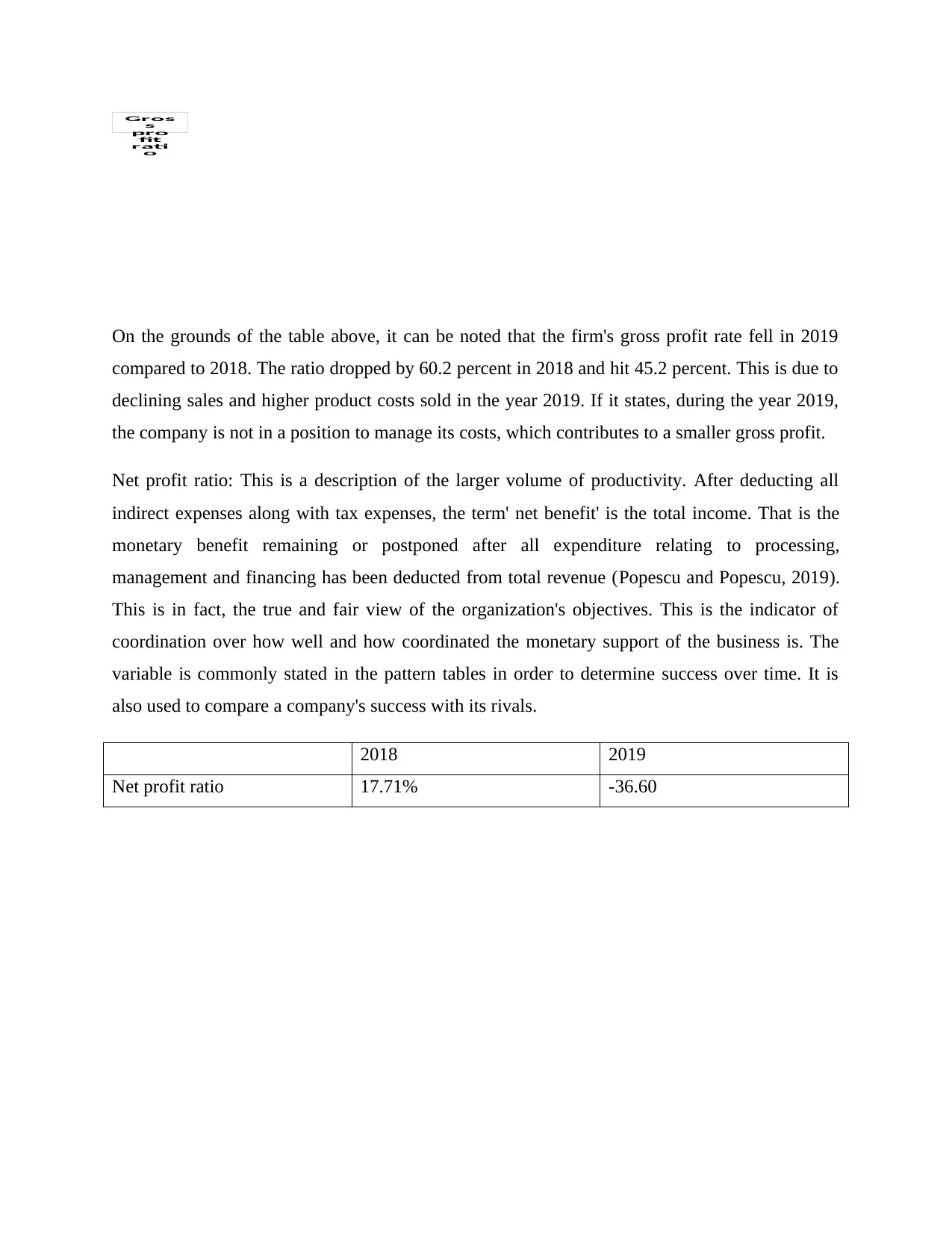
Gros
s
pro
fit
rati
o
On the grounds of the table above, it can be noted that the firm's gross profit rate fell in 2019
compared to 2018. The ratio dropped by 60.2 percent in 2018 and hit 45.2 percent. This is due to
declining sales and higher product costs sold in the year 2019. If it states, during the year 2019,
the company is not in a position to manage its costs, which contributes to a smaller gross profit.
Net profit ratio: This is a description of the larger volume of productivity. After deducting all
indirect expenses along with tax expenses, the term' net benefit' is the total income. That is the
monetary benefit remaining or postponed after all expenditure relating to processing,
management and financing has been deducted from total revenue (Popescu and Popescu, 2019).
This is in fact, the true and fair view of the organization's objectives. This is the indicator of
coordination over how well and how coordinated the monetary support of the business is. The
variable is commonly stated in the pattern tables in order to determine success over time. It is
also used to compare a company's success with its rivals.
2018 2019
Net profit ratio 17.71% -36.60
s
pro
fit
rati
o
On the grounds of the table above, it can be noted that the firm's gross profit rate fell in 2019
compared to 2018. The ratio dropped by 60.2 percent in 2018 and hit 45.2 percent. This is due to
declining sales and higher product costs sold in the year 2019. If it states, during the year 2019,
the company is not in a position to manage its costs, which contributes to a smaller gross profit.
Net profit ratio: This is a description of the larger volume of productivity. After deducting all
indirect expenses along with tax expenses, the term' net benefit' is the total income. That is the
monetary benefit remaining or postponed after all expenditure relating to processing,
management and financing has been deducted from total revenue (Popescu and Popescu, 2019).
This is in fact, the true and fair view of the organization's objectives. This is the indicator of
coordination over how well and how coordinated the monetary support of the business is. The
variable is commonly stated in the pattern tables in order to determine success over time. It is
also used to compare a company's success with its rivals.
2018 2019
Net profit ratio 17.71% -36.60
Paraphrase This Document
Need a fresh take? Get an instant paraphrase of this document with our AI Paraphraser
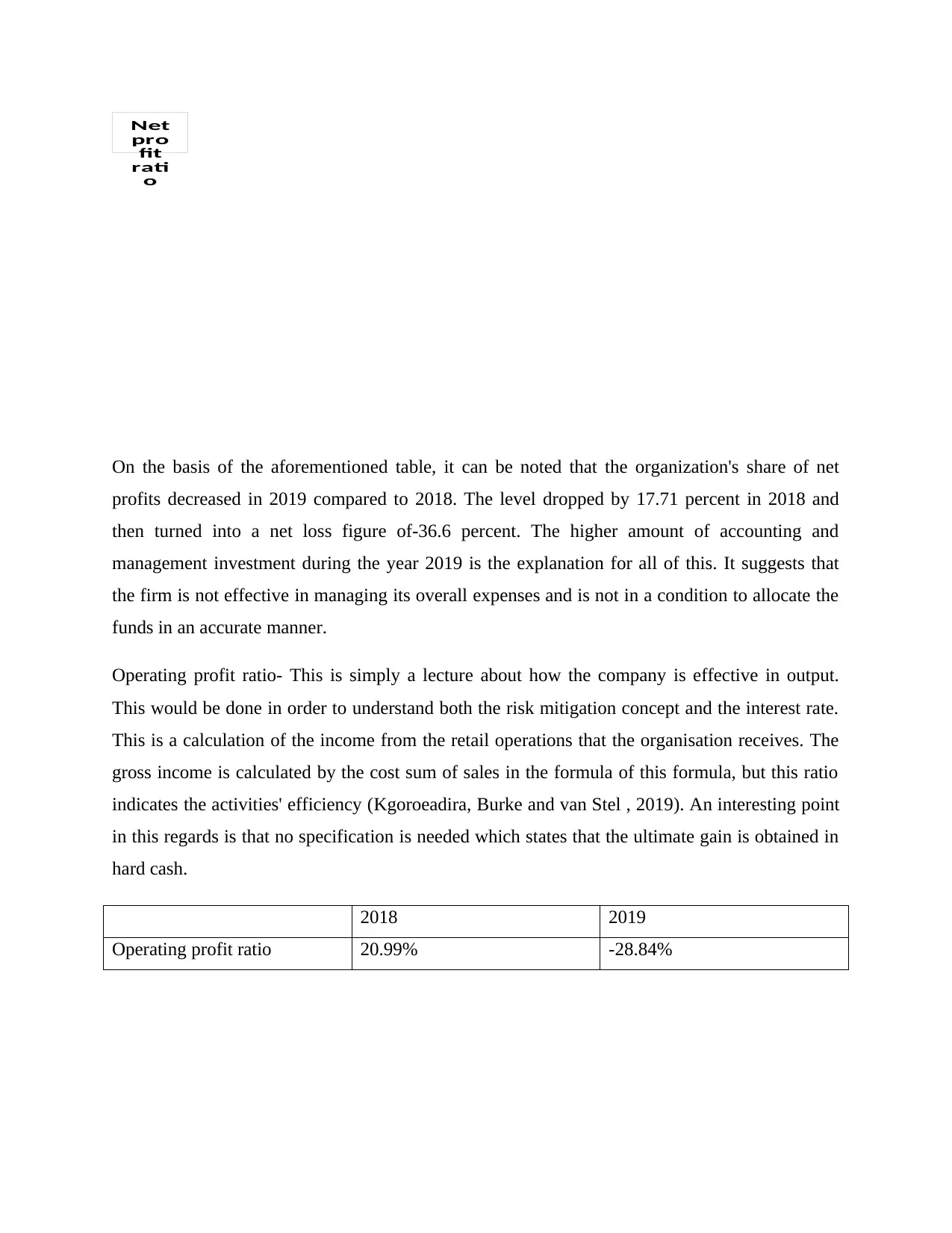
Net
pro
fit
rati
o
On the basis of the aforementioned table, it can be noted that the organization's share of net
profits decreased in 2019 compared to 2018. The level dropped by 17.71 percent in 2018 and
then turned into a net loss figure of-36.6 percent. The higher amount of accounting and
management investment during the year 2019 is the explanation for all of this. It suggests that
the firm is not effective in managing its overall expenses and is not in a condition to allocate the
funds in an accurate manner.
Operating profit ratio- This is simply a lecture about how the company is effective in output.
This would be done in order to understand both the risk mitigation concept and the interest rate.
This is a calculation of the income from the retail operations that the organisation receives. The
gross income is calculated by the cost sum of sales in the formula of this formula, but this ratio
indicates the activities' efficiency (Kgoroeadira, Burke and van Stel , 2019). An interesting point
in this regards is that no specification is needed which states that the ultimate gain is obtained in
hard cash.
2018 2019
Operating profit ratio 20.99% -28.84%
pro
fit
rati
o
On the basis of the aforementioned table, it can be noted that the organization's share of net
profits decreased in 2019 compared to 2018. The level dropped by 17.71 percent in 2018 and
then turned into a net loss figure of-36.6 percent. The higher amount of accounting and
management investment during the year 2019 is the explanation for all of this. It suggests that
the firm is not effective in managing its overall expenses and is not in a condition to allocate the
funds in an accurate manner.
Operating profit ratio- This is simply a lecture about how the company is effective in output.
This would be done in order to understand both the risk mitigation concept and the interest rate.
This is a calculation of the income from the retail operations that the organisation receives. The
gross income is calculated by the cost sum of sales in the formula of this formula, but this ratio
indicates the activities' efficiency (Kgoroeadira, Burke and van Stel , 2019). An interesting point
in this regards is that no specification is needed which states that the ultimate gain is obtained in
hard cash.
2018 2019
Operating profit ratio 20.99% -28.84%
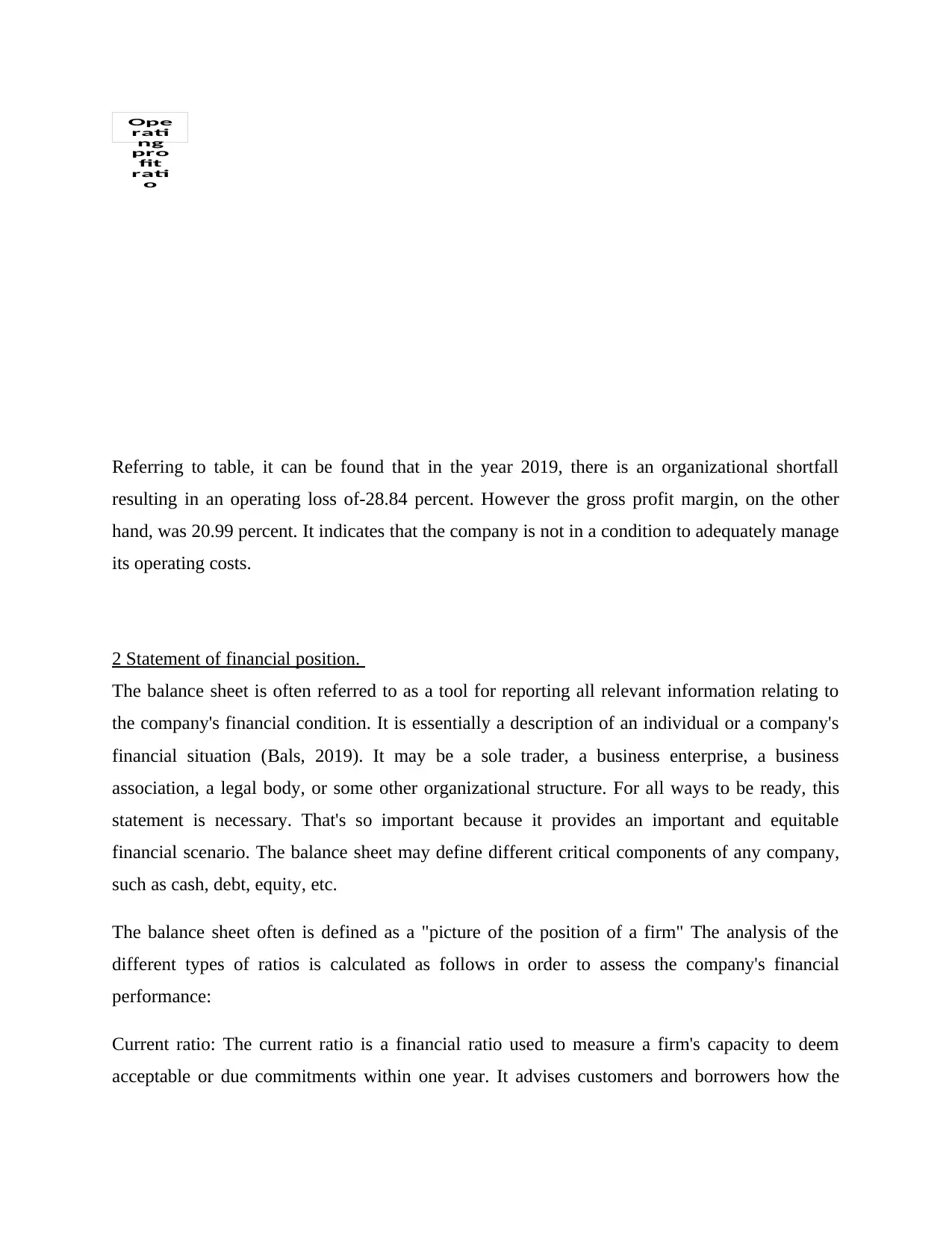
Ope
rati
ng
pro
fit
rati
o
Referring to table, it can be found that in the year 2019, there is an organizational shortfall
resulting in an operating loss of-28.84 percent. However the gross profit margin, on the other
hand, was 20.99 percent. It indicates that the company is not in a condition to adequately manage
its operating costs.
2 Statement of financial position.
The balance sheet is often referred to as a tool for reporting all relevant information relating to
the company's financial condition. It is essentially a description of an individual or a company's
financial situation (Bals, 2019). It may be a sole trader, a business enterprise, a business
association, a legal body, or some other organizational structure. For all ways to be ready, this
statement is necessary. That's so important because it provides an important and equitable
financial scenario. The balance sheet may define different critical components of any company,
such as cash, debt, equity, etc.
The balance sheet often is defined as a "picture of the position of a firm" The analysis of the
different types of ratios is calculated as follows in order to assess the company's financial
performance:
Current ratio: The current ratio is a financial ratio used to measure a firm's capacity to deem
acceptable or due commitments within one year. It advises customers and borrowers how the
rati
ng
pro
fit
rati
o
Referring to table, it can be found that in the year 2019, there is an organizational shortfall
resulting in an operating loss of-28.84 percent. However the gross profit margin, on the other
hand, was 20.99 percent. It indicates that the company is not in a condition to adequately manage
its operating costs.
2 Statement of financial position.
The balance sheet is often referred to as a tool for reporting all relevant information relating to
the company's financial condition. It is essentially a description of an individual or a company's
financial situation (Bals, 2019). It may be a sole trader, a business enterprise, a business
association, a legal body, or some other organizational structure. For all ways to be ready, this
statement is necessary. That's so important because it provides an important and equitable
financial scenario. The balance sheet may define different critical components of any company,
such as cash, debt, equity, etc.
The balance sheet often is defined as a "picture of the position of a firm" The analysis of the
different types of ratios is calculated as follows in order to assess the company's financial
performance:
Current ratio: The current ratio is a financial ratio used to measure a firm's capacity to deem
acceptable or due commitments within one year. It advises customers and borrowers how the
⊘ This is a preview!⊘
Do you want full access?
Subscribe today to unlock all pages.

Trusted by 1+ million students worldwide
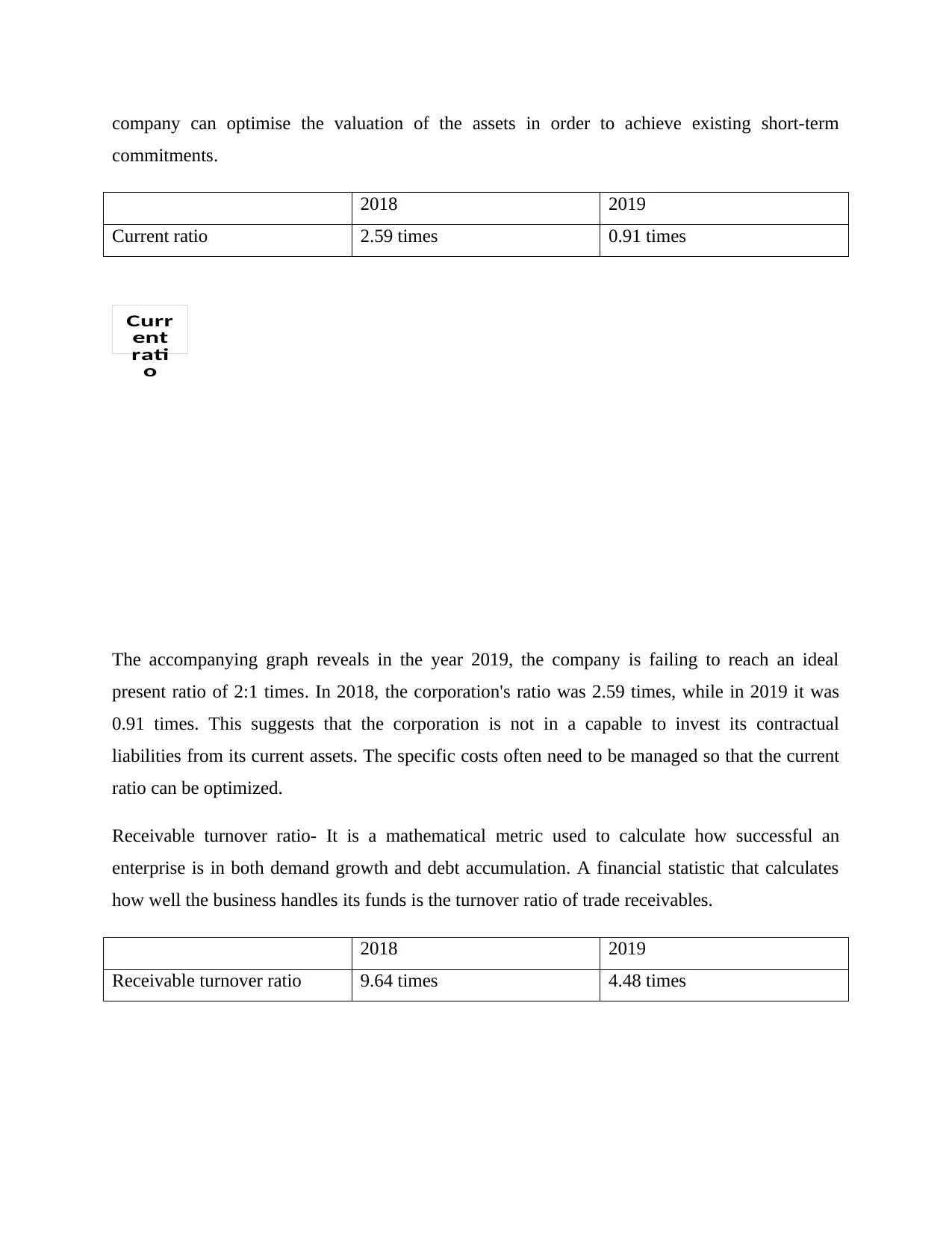
company can optimise the valuation of the assets in order to achieve existing short-term
commitments.
2018 2019
Current ratio 2.59 times 0.91 times
Curr
ent
rati
o
The accompanying graph reveals in the year 2019, the company is failing to reach an ideal
present ratio of 2:1 times. In 2018, the corporation's ratio was 2.59 times, while in 2019 it was
0.91 times. This suggests that the corporation is not in a capable to invest its contractual
liabilities from its current assets. The specific costs often need to be managed so that the current
ratio can be optimized.
Receivable turnover ratio- It is a mathematical metric used to calculate how successful an
enterprise is in both demand growth and debt accumulation. A financial statistic that calculates
how well the business handles its funds is the turnover ratio of trade receivables.
2018 2019
Receivable turnover ratio 9.64 times 4.48 times
commitments.
2018 2019
Current ratio 2.59 times 0.91 times
Curr
ent
rati
o
The accompanying graph reveals in the year 2019, the company is failing to reach an ideal
present ratio of 2:1 times. In 2018, the corporation's ratio was 2.59 times, while in 2019 it was
0.91 times. This suggests that the corporation is not in a capable to invest its contractual
liabilities from its current assets. The specific costs often need to be managed so that the current
ratio can be optimized.
Receivable turnover ratio- It is a mathematical metric used to calculate how successful an
enterprise is in both demand growth and debt accumulation. A financial statistic that calculates
how well the business handles its funds is the turnover ratio of trade receivables.
2018 2019
Receivable turnover ratio 9.64 times 4.48 times
Paraphrase This Document
Need a fresh take? Get an instant paraphrase of this document with our AI Paraphraser
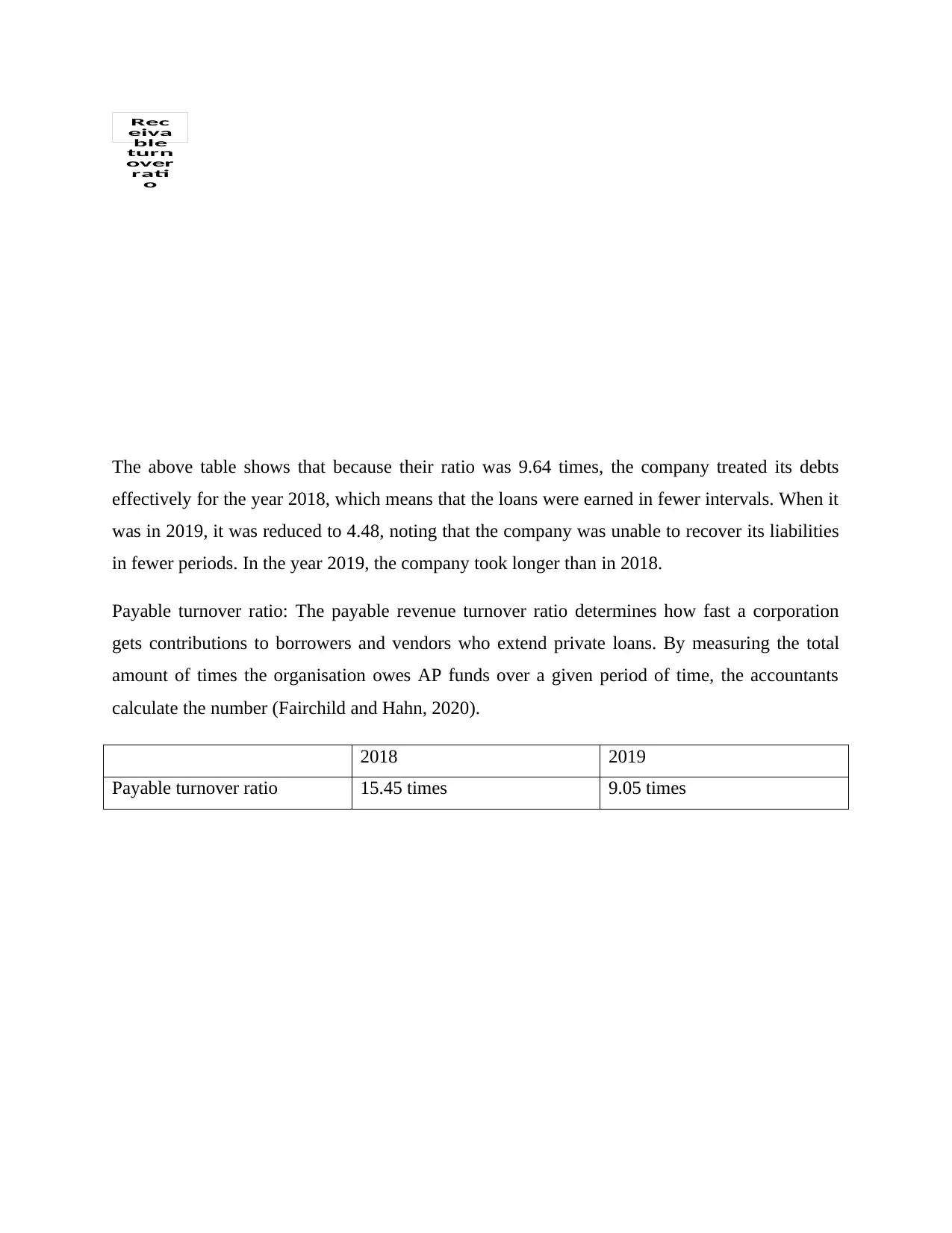
Rec
eiva
ble
turn
over
rati
o
The above table shows that because their ratio was 9.64 times, the company treated its debts
effectively for the year 2018, which means that the loans were earned in fewer intervals. When it
was in 2019, it was reduced to 4.48, noting that the company was unable to recover its liabilities
in fewer periods. In the year 2019, the company took longer than in 2018.
Payable turnover ratio: The payable revenue turnover ratio determines how fast a corporation
gets contributions to borrowers and vendors who extend private loans. By measuring the total
amount of times the organisation owes AP funds over a given period of time, the accountants
calculate the number (Fairchild and Hahn, 2020).
2018 2019
Payable turnover ratio 15.45 times 9.05 times
eiva
ble
turn
over
rati
o
The above table shows that because their ratio was 9.64 times, the company treated its debts
effectively for the year 2018, which means that the loans were earned in fewer intervals. When it
was in 2019, it was reduced to 4.48, noting that the company was unable to recover its liabilities
in fewer periods. In the year 2019, the company took longer than in 2018.
Payable turnover ratio: The payable revenue turnover ratio determines how fast a corporation
gets contributions to borrowers and vendors who extend private loans. By measuring the total
amount of times the organisation owes AP funds over a given period of time, the accountants
calculate the number (Fairchild and Hahn, 2020).
2018 2019
Payable turnover ratio 15.45 times 9.05 times

Pay
able
turn
over
rati
o
The above table reveals that while their ratio was 15.45 times, the company treated its
commitments in a good manner for 2018 that implies that their debts were paid in fewer
intervals. While it declined in 2019, it was 9.05 times that perhaps the corporation was unable to
pay its commitments in fewer periods. In the year 2019, the company took longer than in 2018.
PART 2
1. Accruals vs. cash accounting
There are basically two options for companies to compensate. Such strategies differ in exactly
one way, which is the essence of a tax. In relation to the calculation of income and expense, all
methods have distinct rhythms as per the rate of reporting in the financial reporting (Bonini and
Capizzi, 2019). More specifically, it should be argued that the reporting form of cash only
describes and tracks all operations related to the selling of cash money or its substitutes. The
accrual method on the other hand, does not have such a sort of differentiation and imposes the
monetary theory. And according to this description, whether cash money is concerned or not, all
transactions should be measured at premium rates.
Accrual accounting method:
And according to this accounting system, a transaction is reported if it can be measured in cash at
the very same period. In the field of salaries, real money transfers are recent example right after
able
turn
over
rati
o
The above table reveals that while their ratio was 15.45 times, the company treated its
commitments in a good manner for 2018 that implies that their debts were paid in fewer
intervals. While it declined in 2019, it was 9.05 times that perhaps the corporation was unable to
pay its commitments in fewer periods. In the year 2019, the company took longer than in 2018.
PART 2
1. Accruals vs. cash accounting
There are basically two options for companies to compensate. Such strategies differ in exactly
one way, which is the essence of a tax. In relation to the calculation of income and expense, all
methods have distinct rhythms as per the rate of reporting in the financial reporting (Bonini and
Capizzi, 2019). More specifically, it should be argued that the reporting form of cash only
describes and tracks all operations related to the selling of cash money or its substitutes. The
accrual method on the other hand, does not have such a sort of differentiation and imposes the
monetary theory. And according to this description, whether cash money is concerned or not, all
transactions should be measured at premium rates.
Accrual accounting method:
And according to this accounting system, a transaction is reported if it can be measured in cash at
the very same period. In the field of salaries, real money transfers are recent example right after
⊘ This is a preview!⊘
Do you want full access?
Subscribe today to unlock all pages.

Trusted by 1+ million students worldwide
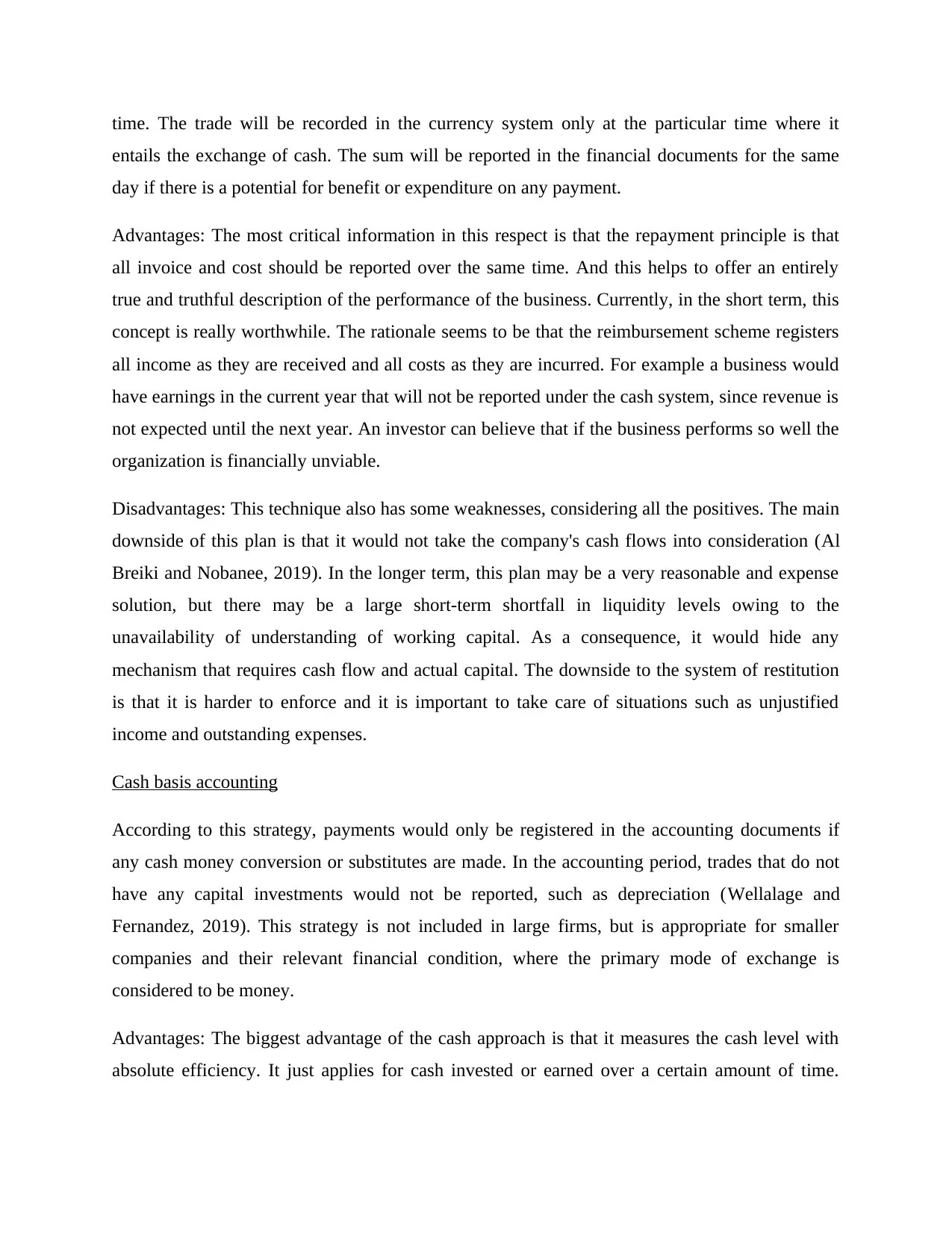
time. The trade will be recorded in the currency system only at the particular time where it
entails the exchange of cash. The sum will be reported in the financial documents for the same
day if there is a potential for benefit or expenditure on any payment.
Advantages: The most critical information in this respect is that the repayment principle is that
all invoice and cost should be reported over the same time. And this helps to offer an entirely
true and truthful description of the performance of the business. Currently, in the short term, this
concept is really worthwhile. The rationale seems to be that the reimbursement scheme registers
all income as they are received and all costs as they are incurred. For example a business would
have earnings in the current year that will not be reported under the cash system, since revenue is
not expected until the next year. An investor can believe that if the business performs so well the
organization is financially unviable.
Disadvantages: This technique also has some weaknesses, considering all the positives. The main
downside of this plan is that it would not take the company's cash flows into consideration (Al
Breiki and Nobanee, 2019). In the longer term, this plan may be a very reasonable and expense
solution, but there may be a large short-term shortfall in liquidity levels owing to the
unavailability of understanding of working capital. As a consequence, it would hide any
mechanism that requires cash flow and actual capital. The downside to the system of restitution
is that it is harder to enforce and it is important to take care of situations such as unjustified
income and outstanding expenses.
Cash basis accounting
According to this strategy, payments would only be registered in the accounting documents if
any cash money conversion or substitutes are made. In the accounting period, trades that do not
have any capital investments would not be reported, such as depreciation (Wellalage and
Fernandez, 2019). This strategy is not included in large firms, but is appropriate for smaller
companies and their relevant financial condition, where the primary mode of exchange is
considered to be money.
Advantages: The biggest advantage of the cash approach is that it measures the cash level with
absolute efficiency. It just applies for cash invested or earned over a certain amount of time.
entails the exchange of cash. The sum will be reported in the financial documents for the same
day if there is a potential for benefit or expenditure on any payment.
Advantages: The most critical information in this respect is that the repayment principle is that
all invoice and cost should be reported over the same time. And this helps to offer an entirely
true and truthful description of the performance of the business. Currently, in the short term, this
concept is really worthwhile. The rationale seems to be that the reimbursement scheme registers
all income as they are received and all costs as they are incurred. For example a business would
have earnings in the current year that will not be reported under the cash system, since revenue is
not expected until the next year. An investor can believe that if the business performs so well the
organization is financially unviable.
Disadvantages: This technique also has some weaknesses, considering all the positives. The main
downside of this plan is that it would not take the company's cash flows into consideration (Al
Breiki and Nobanee, 2019). In the longer term, this plan may be a very reasonable and expense
solution, but there may be a large short-term shortfall in liquidity levels owing to the
unavailability of understanding of working capital. As a consequence, it would hide any
mechanism that requires cash flow and actual capital. The downside to the system of restitution
is that it is harder to enforce and it is important to take care of situations such as unjustified
income and outstanding expenses.
Cash basis accounting
According to this strategy, payments would only be registered in the accounting documents if
any cash money conversion or substitutes are made. In the accounting period, trades that do not
have any capital investments would not be reported, such as depreciation (Wellalage and
Fernandez, 2019). This strategy is not included in large firms, but is appropriate for smaller
companies and their relevant financial condition, where the primary mode of exchange is
considered to be money.
Advantages: The biggest advantage of the cash approach is that it measures the cash level with
absolute efficiency. It just applies for cash invested or earned over a certain amount of time.
Paraphrase This Document
Need a fresh take? Get an instant paraphrase of this document with our AI Paraphraser
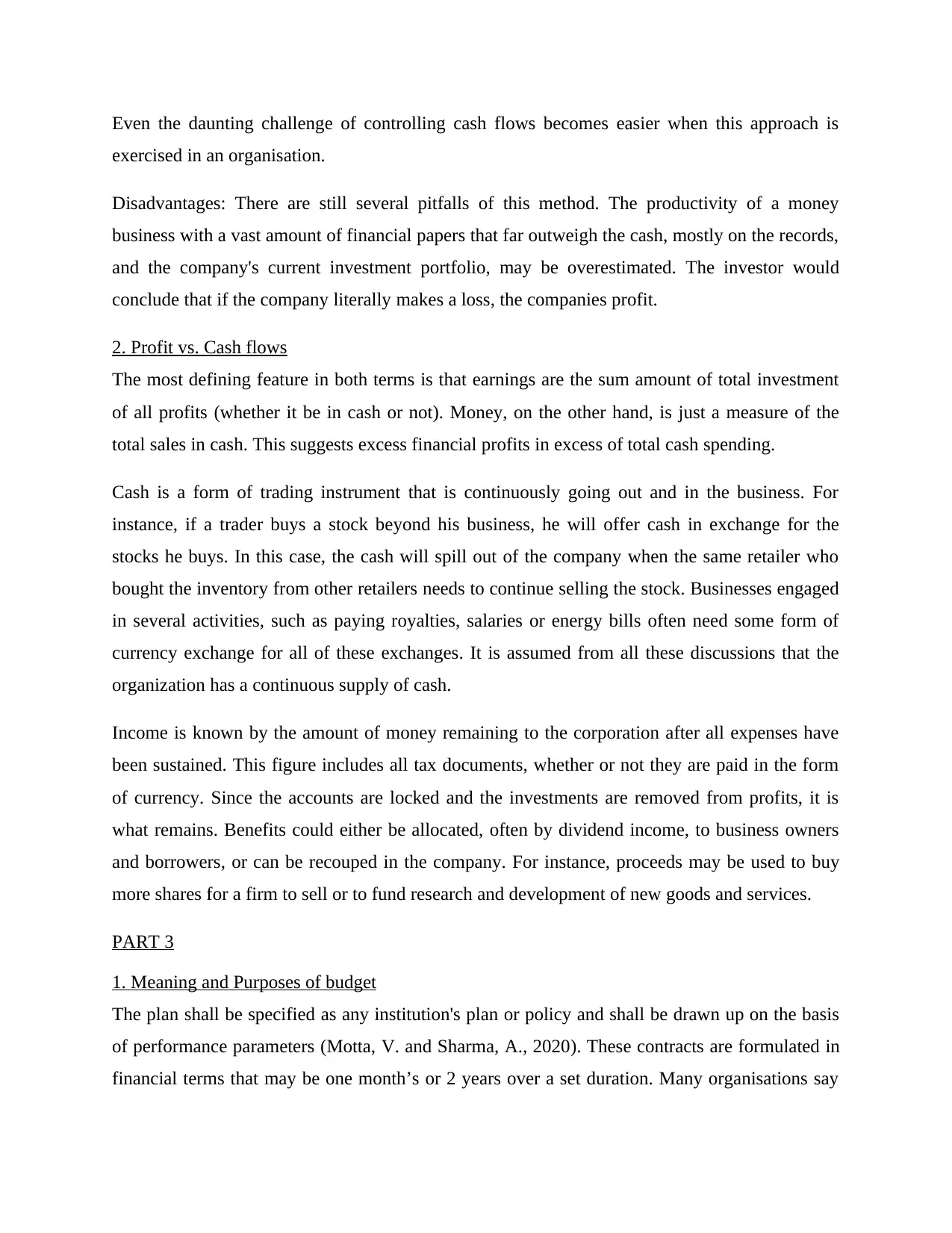
Even the daunting challenge of controlling cash flows becomes easier when this approach is
exercised in an organisation.
Disadvantages: There are still several pitfalls of this method. The productivity of a money
business with a vast amount of financial papers that far outweigh the cash, mostly on the records,
and the company's current investment portfolio, may be overestimated. The investor would
conclude that if the company literally makes a loss, the companies profit.
2. Profit vs. Cash flows
The most defining feature in both terms is that earnings are the sum amount of total investment
of all profits (whether it be in cash or not). Money, on the other hand, is just a measure of the
total sales in cash. This suggests excess financial profits in excess of total cash spending.
Cash is a form of trading instrument that is continuously going out and in the business. For
instance, if a trader buys a stock beyond his business, he will offer cash in exchange for the
stocks he buys. In this case, the cash will spill out of the company when the same retailer who
bought the inventory from other retailers needs to continue selling the stock. Businesses engaged
in several activities, such as paying royalties, salaries or energy bills often need some form of
currency exchange for all of these exchanges. It is assumed from all these discussions that the
organization has a continuous supply of cash.
Income is known by the amount of money remaining to the corporation after all expenses have
been sustained. This figure includes all tax documents, whether or not they are paid in the form
of currency. Since the accounts are locked and the investments are removed from profits, it is
what remains. Benefits could either be allocated, often by dividend income, to business owners
and borrowers, or can be recouped in the company. For instance, proceeds may be used to buy
more shares for a firm to sell or to fund research and development of new goods and services.
PART 3
1. Meaning and Purposes of budget
The plan shall be specified as any institution's plan or policy and shall be drawn up on the basis
of performance parameters (Motta, V. and Sharma, A., 2020). These contracts are formulated in
financial terms that may be one month’s or 2 years over a set duration. Many organisations say
exercised in an organisation.
Disadvantages: There are still several pitfalls of this method. The productivity of a money
business with a vast amount of financial papers that far outweigh the cash, mostly on the records,
and the company's current investment portfolio, may be overestimated. The investor would
conclude that if the company literally makes a loss, the companies profit.
2. Profit vs. Cash flows
The most defining feature in both terms is that earnings are the sum amount of total investment
of all profits (whether it be in cash or not). Money, on the other hand, is just a measure of the
total sales in cash. This suggests excess financial profits in excess of total cash spending.
Cash is a form of trading instrument that is continuously going out and in the business. For
instance, if a trader buys a stock beyond his business, he will offer cash in exchange for the
stocks he buys. In this case, the cash will spill out of the company when the same retailer who
bought the inventory from other retailers needs to continue selling the stock. Businesses engaged
in several activities, such as paying royalties, salaries or energy bills often need some form of
currency exchange for all of these exchanges. It is assumed from all these discussions that the
organization has a continuous supply of cash.
Income is known by the amount of money remaining to the corporation after all expenses have
been sustained. This figure includes all tax documents, whether or not they are paid in the form
of currency. Since the accounts are locked and the investments are removed from profits, it is
what remains. Benefits could either be allocated, often by dividend income, to business owners
and borrowers, or can be recouped in the company. For instance, proceeds may be used to buy
more shares for a firm to sell or to fund research and development of new goods and services.
PART 3
1. Meaning and Purposes of budget
The plan shall be specified as any institution's plan or policy and shall be drawn up on the basis
of performance parameters (Motta, V. and Sharma, A., 2020). These contracts are formulated in
financial terms that may be one month’s or 2 years over a set duration. Many organisations say
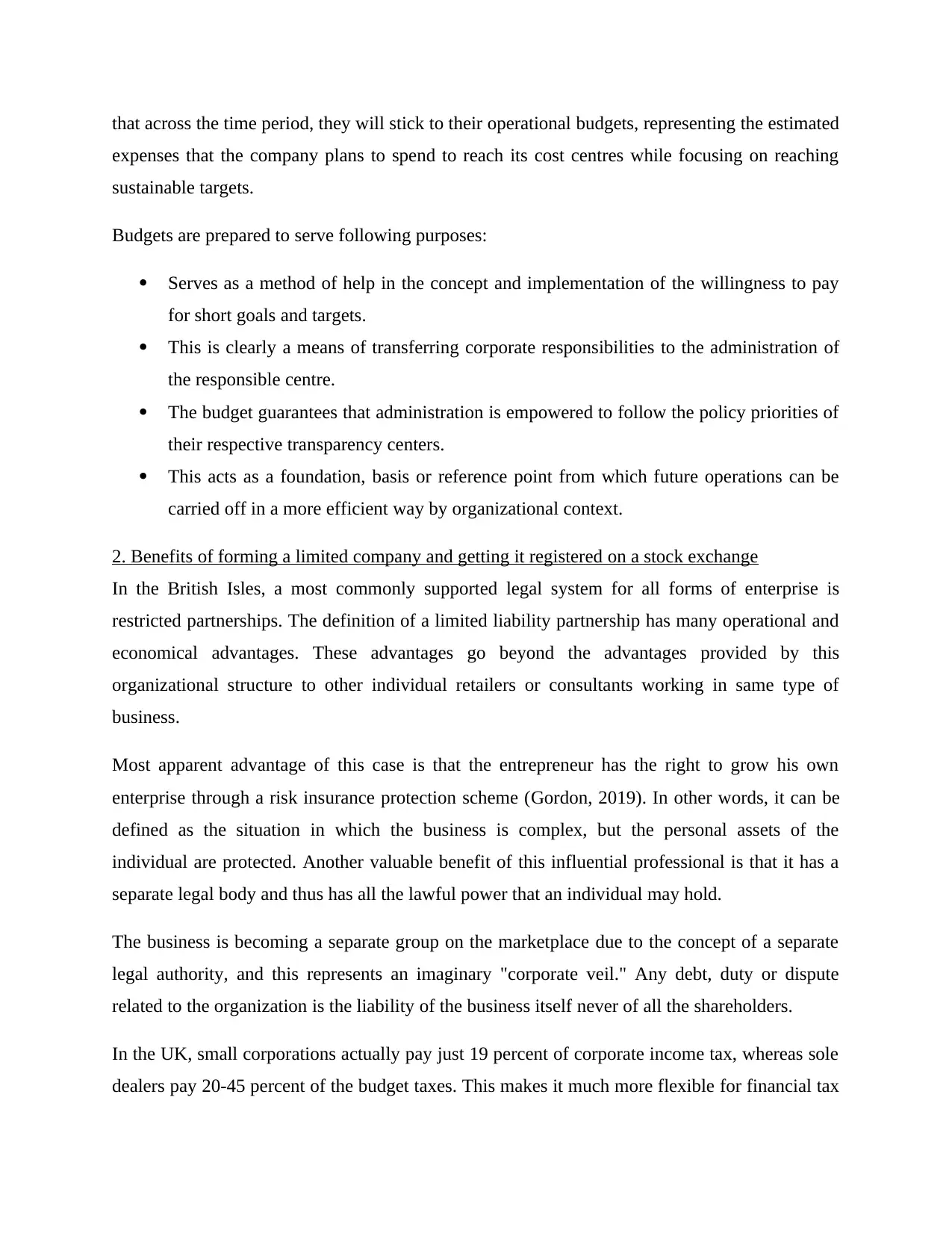
that across the time period, they will stick to their operational budgets, representing the estimated
expenses that the company plans to spend to reach its cost centres while focusing on reaching
sustainable targets.
Budgets are prepared to serve following purposes:
Serves as a method of help in the concept and implementation of the willingness to pay
for short goals and targets.
This is clearly a means of transferring corporate responsibilities to the administration of
the responsible centre.
The budget guarantees that administration is empowered to follow the policy priorities of
their respective transparency centers.
This acts as a foundation, basis or reference point from which future operations can be
carried off in a more efficient way by organizational context.
2. Benefits of forming a limited company and getting it registered on a stock exchange
In the British Isles, a most commonly supported legal system for all forms of enterprise is
restricted partnerships. The definition of a limited liability partnership has many operational and
economical advantages. These advantages go beyond the advantages provided by this
organizational structure to other individual retailers or consultants working in same type of
business.
Most apparent advantage of this case is that the entrepreneur has the right to grow his own
enterprise through a risk insurance protection scheme (Gordon, 2019). In other words, it can be
defined as the situation in which the business is complex, but the personal assets of the
individual are protected. Another valuable benefit of this influential professional is that it has a
separate legal body and thus has all the lawful power that an individual may hold.
The business is becoming a separate group on the marketplace due to the concept of a separate
legal authority, and this represents an imaginary "corporate veil." Any debt, duty or dispute
related to the organization is the liability of the business itself never of all the shareholders.
In the UK, small corporations actually pay just 19 percent of corporate income tax, whereas sole
dealers pay 20-45 percent of the budget taxes. This makes it much more flexible for financial tax
expenses that the company plans to spend to reach its cost centres while focusing on reaching
sustainable targets.
Budgets are prepared to serve following purposes:
Serves as a method of help in the concept and implementation of the willingness to pay
for short goals and targets.
This is clearly a means of transferring corporate responsibilities to the administration of
the responsible centre.
The budget guarantees that administration is empowered to follow the policy priorities of
their respective transparency centers.
This acts as a foundation, basis or reference point from which future operations can be
carried off in a more efficient way by organizational context.
2. Benefits of forming a limited company and getting it registered on a stock exchange
In the British Isles, a most commonly supported legal system for all forms of enterprise is
restricted partnerships. The definition of a limited liability partnership has many operational and
economical advantages. These advantages go beyond the advantages provided by this
organizational structure to other individual retailers or consultants working in same type of
business.
Most apparent advantage of this case is that the entrepreneur has the right to grow his own
enterprise through a risk insurance protection scheme (Gordon, 2019). In other words, it can be
defined as the situation in which the business is complex, but the personal assets of the
individual are protected. Another valuable benefit of this influential professional is that it has a
separate legal body and thus has all the lawful power that an individual may hold.
The business is becoming a separate group on the marketplace due to the concept of a separate
legal authority, and this represents an imaginary "corporate veil." Any debt, duty or dispute
related to the organization is the liability of the business itself never of all the shareholders.
In the UK, small corporations actually pay just 19 percent of corporate income tax, whereas sole
dealers pay 20-45 percent of the budget taxes. This makes it much more flexible for financial tax
⊘ This is a preview!⊘
Do you want full access?
Subscribe today to unlock all pages.

Trusted by 1+ million students worldwide
1 out of 15
Related Documents
Your All-in-One AI-Powered Toolkit for Academic Success.
+13062052269
info@desklib.com
Available 24*7 on WhatsApp / Email
![[object Object]](/_next/static/media/star-bottom.7253800d.svg)
Unlock your academic potential
Copyright © 2020–2026 A2Z Services. All Rights Reserved. Developed and managed by ZUCOL.





